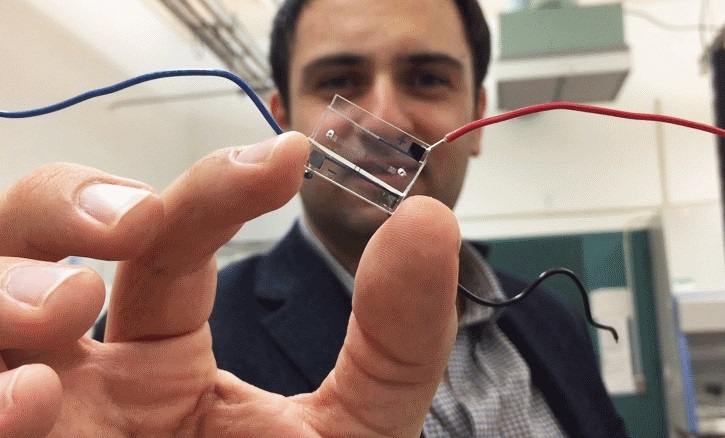Phone calls and text messages reach you wherever you are because your phone has a unique identifying number that sets you apart from everybody else on the network. Researchers at the Georgia Institute of Technology are using a similar principle to track cells being sorted on microfluidic chips. The technique uses a simple circuit pattern with just three electrodes to assign a unique seven-bit digital identification number to each cell passing through the channels on the microfluidic chip. The underlying principle for the cell identification is called code division multiple access (CDMA), and it’s essential for helping cellular networks separate the signals from each user. The new technique also captures information about the sizes of the cells and how fast they are moving. That identification and information could allow for automated counting and analysis of the cells being sorted.
The research could provide the electronic intelligence that might one day allow inexpensive labs-on-a-chip to conduct sophisticated medical testing outside the confines of hospitals and clinics. The technology can track cells with better than 90% accuracy in a four-channel chip. These microfluidic chips use the unique biophysical or biochemical properties of cells and viruses to separate them. For instance, antigens can be used to select bacteria or cancer cells and route them into separate channels. But to obtain information about the results of the sorting, those cells must be counted using optical methods.

Researchers hope to create inexpensive chips for sophisticated diagnostic testing in physicians’ offices or remote locations.
The new technique, dubbed microfluidic CODES, adds a grid of micron-scale electrical circuitry beneath the microfluidic chip. Current flowing through the circuitry creates an electrical field in the microfluidic channels above the grid. When a cell passes through one of the microfluidic channels, it creates an impedance change in the circuitry that signals the cell’s passage and provides information about the cell’s location, size, and the speed at which it is moving through the channel. This impedance change has been used for many years to detect the presence of cells in a fluid, and it allows blood counts to be done quickly and reliably. The unique identifying signals from multiple cells can be separated and read by a computer, allowing scientists to track not only the properties of the cells, but also how many cells have passed through each channel. Because the cells sorted into each channel of a microfluidic chip have certain characteristics in common, the technique would allow the automated detection of cancer cells, bacteria, or even viruses in a fluid sample. The researchers have demonstrated that they can track more than 1,000 ovarian cancer cells with an accuracy rate of better than 90%. The next step in the research will be to combine the electronic sensor with a microfluidic chip that can actively sort cells. Beyond cancer cells, bacteria, and viruses, such a system could also sort and analyze inorganic particles.
The computing requirements of the system would be minimal, requiring no more than the processor power of smartphones that already handle the decoding of CDMA signals. The proof-of-principle device contains just four channels, but it could be scaled up to include many more. Ultimately, the researchers hope to create inexpensive chips that could be used for sophisticated diagnostic testing in physicians’ offices or remote locations. Chips might be contained on cartridges that would automate the testing process. The technology might one day allow many kinds of diagnostic tests to be done beyond hospitals and large medical facilities. See the video describing the concept: https://youtu.be/FJT8P8LGEIY .
Advertisement





